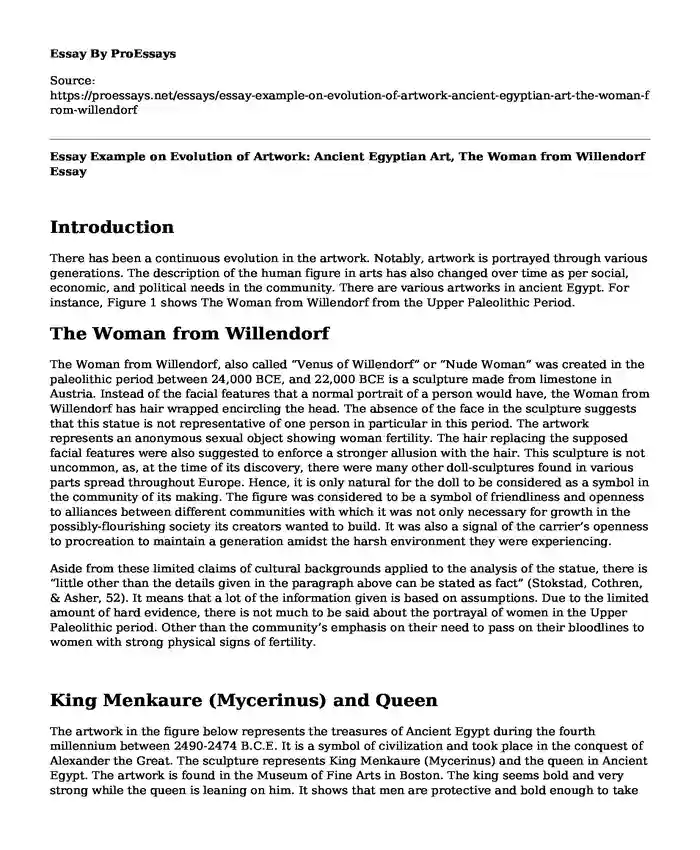Introduction
There has been a continuous evolution in the artwork. Notably, artwork is portrayed through various generations. The description of the human figure in arts has also changed over time as per social, economic, and political needs in the community. There are various artworks in ancient Egypt. For instance, Figure 1 shows The Woman from Willendorf from the Upper Paleolithic Period.
The Woman from Willendorf
The Woman from Willendorf, also called “Venus of Willendorf” or “Nude Woman” was created in the paleolithic period between 24,000 BCE, and 22,000 BCE is a sculpture made from limestone in Austria. Instead of the facial features that a normal portrait of a person would have, the Woman from Willendorf has hair wrapped encircling the head. The absence of the face in the sculpture suggests that this statue is not representative of one person in particular in this period. The artwork represents an anonymous sexual object showing woman fertility. The hair replacing the supposed facial features were also suggested to enforce a stronger allusion with the hair. This sculpture is not uncommon, as, at the time of its discovery, there were many other doll-sculptures found in various parts spread throughout Europe. Hence, it is only natural for the doll to be considered as a symbol in the community of its making. The figure was considered to be a symbol of friendliness and openness to alliances between different communities with which it was not only necessary for growth in the possibly-flourishing society its creators wanted to build. It was also a signal of the carrier’s openness to procreation to maintain a generation amidst the harsh environment they were experiencing.
Aside from these limited claims of cultural backgrounds applied to the analysis of the statue, there is “little other than the details given in the paragraph above can be stated as fact” (Stokstad, Cothren, & Asher, 52). It means that a lot of the information given is based on assumptions. Due to the limited amount of hard evidence, there is not much to be said about the portrayal of women in the Upper Paleolithic period. Other than the community’s emphasis on their need to pass on their bloodlines to women with strong physical signs of fertility.
King Menkaure (Mycerinus) and Queen
The artwork in the figure below represents the treasures of Ancient Egypt during the fourth millennium between 2490-2474 B.C.E. It is a symbol of civilization and took place in the conquest of Alexander the Great. The sculpture represents King Menkaure (Mycerinus) and the queen in Ancient Egypt. The artwork is found in the Museum of Fine Arts in Boston. The king seems bold and very strong while the queen is leaning on him. It shows that men are protective and bold enough to take care of society. Notably, the queen seems very comfortable and protected. The queen also seems very loyal to the king. The sculpture is modeled to emphasize feminine beauty. The artwork shows the rebirth for the king in the Afterlife.
References
Stokstad, Marilyn, Michael Watt Cothren, and Frederick M. Asher. Art history. New York: Harry N. Abrams, 1999.
Cite this page
Essay Example on Evolution of Artwork: Ancient Egyptian Art, The Woman from Willendorf. (2023, Sep 10). Retrieved from https://proessays.net/essays/essay-example-on-evolution-of-artwork-ancient-egyptian-art-the-woman-from-willendorf
If you are the original author of this essay and no longer wish to have it published on the ProEssays website, please click below to request its removal:
- Nixon and Obama Contribution to Humanities Paper Example
- Analysis of the Movie Selma - Essay Sample
- A Dance Critique of "Rich Man's Frug"
- Charles Henry Alston: African Art Influences - Research Paper
- Movie Analysis Essay on Lords of Dogtown
- Essay on 12 Years a Slave: Cultural Relativism and Norms in 19th Century Culture
- Protecting Architecture from Politics: Michael Sorkin's All Over the Map - Book Review Example







